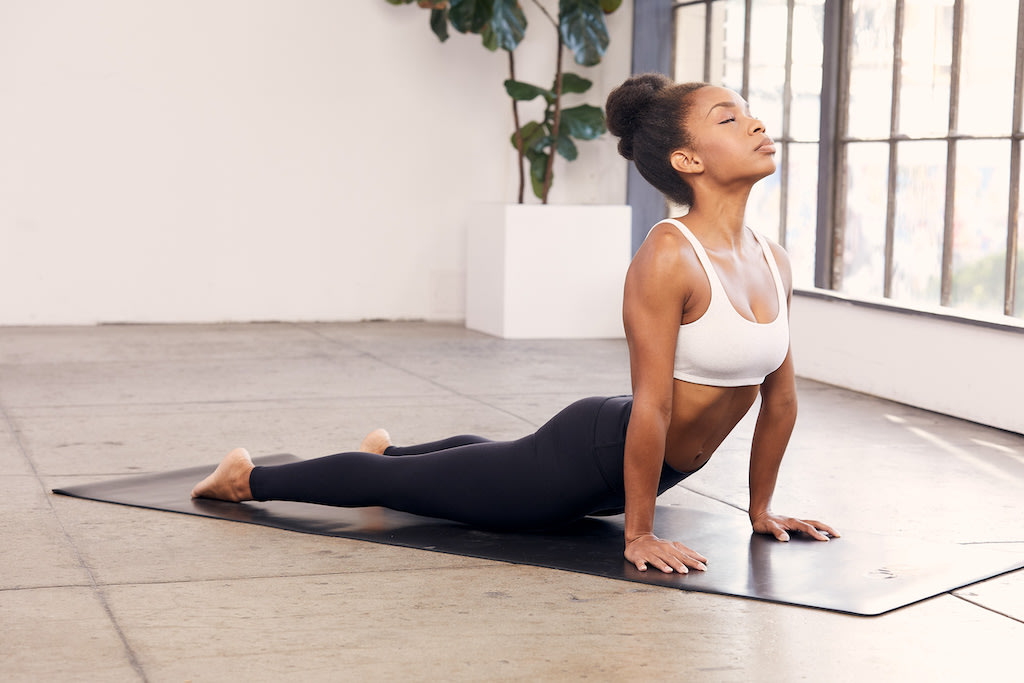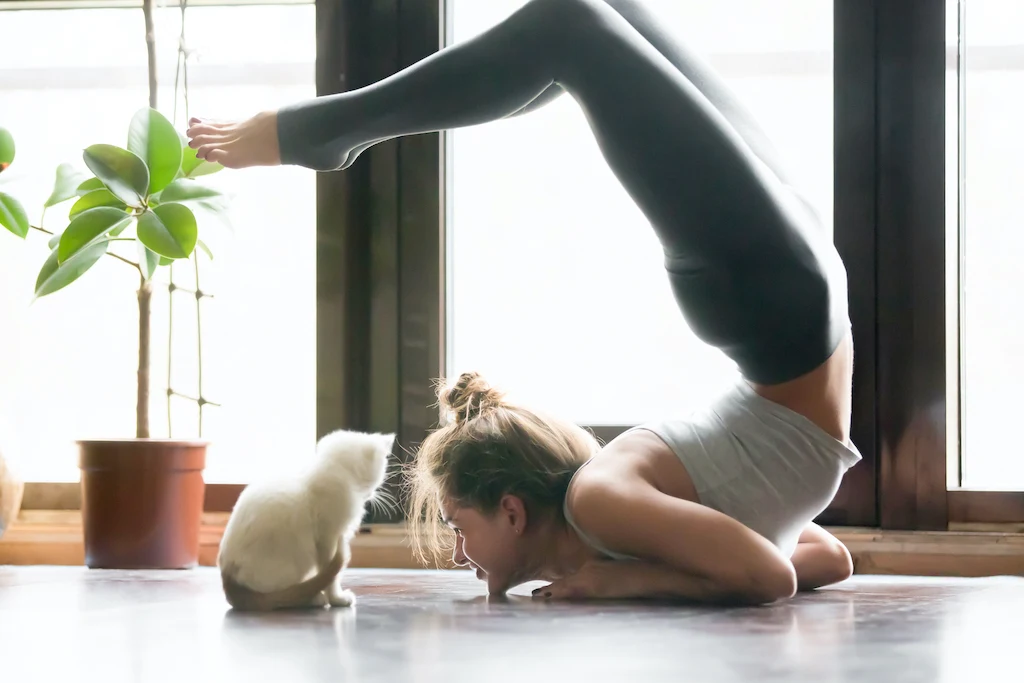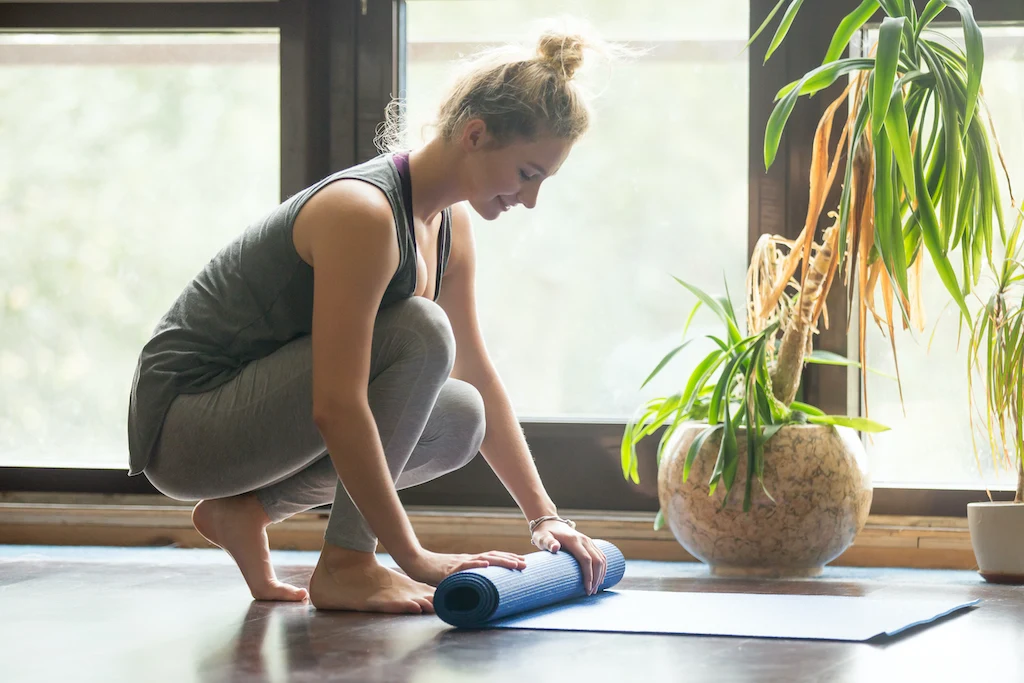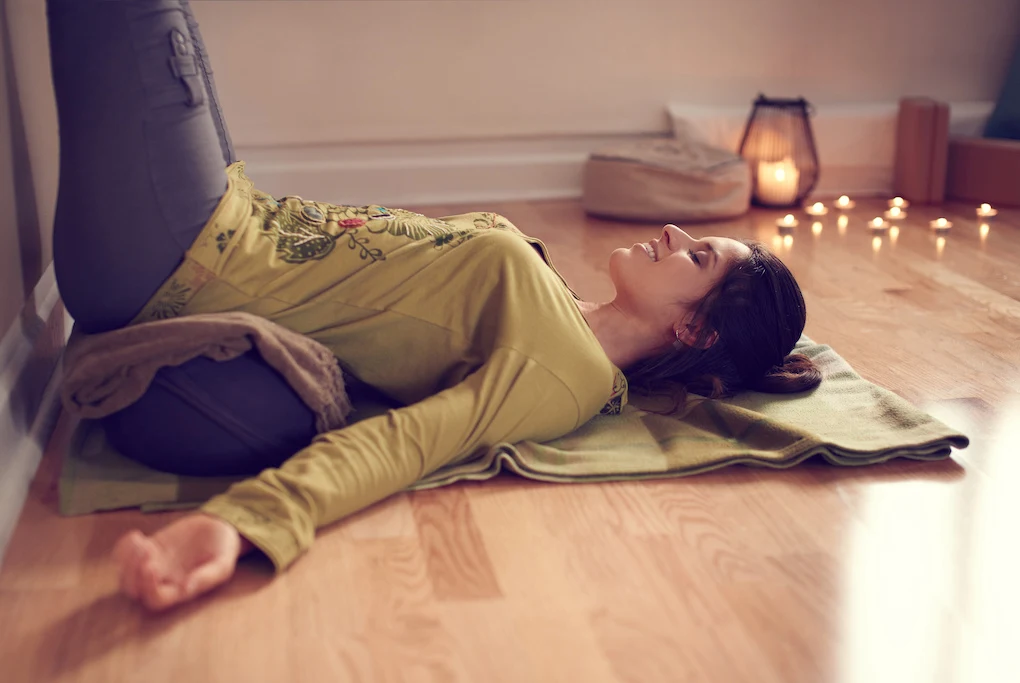How To Start An At-Home Yoga Practice

May 11, 2020

Starting your yoga practice is an exciting and enjoyable experience. But if you’re a complete beginner at yoga, or you are new to doing yoga at home, you may need some tips before getting started.
Yoga is an ongoing practice that can be done in a class setting or on your own as an at-home workout. When practicing yoga on your own at home, it’s important to know which poses to do and how to do them correctly.
Learn about:
How to get started with yoga at home
Yoga is all about mindful movement — doing exercise that supports your physical body while also allowing you to access a meditative state. It should calm you, while also energising your body and releasing tension. You should keep this in mind when starting your at-home yoga practice.
To get started, you’ll need to first decide what kind of yoga you want to practice and how you would like to practice it. This comes down to choosing your space for your practice, learning some yoga poses (also known as asanas), and ensuring you have everything you need to get the most out of yoga.

Benefits of doing yoga at home
There are many health benefits of yoga, from increased strength and fitness, to improved mood and mental health. But there are also some particular advantages to doing yoga at home.
Practice whenever you want
If you’ve ever attended a yoga or workout class before, you might have discovered the stress of trying to get there on time (especially if the class is particularly early in the morning). When doing yoga at home, you remove this added stress and can practice whenever suits you.
Create your own space
You have control over what your yoga space looks and sounds like — from the music you play to the decor. This means you can make the space completely unique to you and your personal preferences.
No comparison or competition
One of the key tenets of yoga is “staying on your mat”. This is meant not in the literal sense, but rather that you should not judge others or compare yourself to others. When doing yoga solo at home, you avoid this comparison and can stay solely “on your mat”.
Make it as challenging or as relaxing as you’d like
You can choose the style of yoga that you do — whether that’s a super challenging strength class or a relaxing, slow flow.

Equipment for doing yoga at home
There are a few key items that you should make sure you have in your at-home yoga space before you begin.
Yoga mat
A yoga mat is the most important piece of equipment you will need for your yoga practice. Most yoga mats are thin and have a strong grip to ensure you don’t slip or slide while practicing.
When choosing your mat, opt for one that feels non-slippery and doesn’t roll up while you are practicing.
Yoga block
Yoga blocks are a very helpful tool for assisting you when doing stretching poses or where you need extra stability such as the Half Moon Pose.
It can also help you reach the floor if you are not flexible enough to touch the floor in a forward fold. Yoga blocks come in multiple shapes and sizes, and can be made of foam, cork, or wood.
Yoga strap
Similarly to a yoga block, yoga straps can make poses more challenging once you are more advanced. It can also assist in making poses less challenging if you don't have the ability to stretch or bend far without the assistance of a strap.
You can use a yoga strap in many different ways, however it is commonly used in forward folds and other leg stretches.

How to set up a space for yoga
When doing yoga at home, you need enough space for your mat and room above and around you to stretch out your body. It also helps to ensure your space is as quiet and clutter-free as possible so that you can truly get into a meditative state.
Choose your music or ambient soundtrack
You may or may not like to have music or sounds playing while you practice yoga. However, playing some calming sounds such as music for meditation or classical music can help you relax and focus on your practice. You should be able to find meditative music and ambient soundtracks on most popular streaming platforms.
Set up your equipment
It can be helpful to make sure your space is set up with the equipment you need. Whether you’re doing yoga in your bedroom or in a dedicated separate room, make sure you store your yoga equipment in the same space so that you always know where it is.
Make your space yours
While not strictly necessary, you might like to elevate your space by burning a candle or incense, and adding in any decor that calms you. Your yoga space should be relaxing and enjoyable for you to be in.
It doesn’t have to be special
Remember, your yoga space doesn’t have to be a dedicated room. You might only have enough space in your home to practice in your bedroom, which is completely fine. The aim is to create an area that is calming, provides enough room to practice, and is free of distractions — you don’t want to practice yoga in front of the tv or in a busy area of your home.

Different styles of yoga
There are many different yoga styles that exist, and each have their different benefits. As a beginner, there are nine prominent styles of yoga that you may like to know about:
Hatha
Hatha is traditionally a catch-all term for all physical yoga practices (i.e. Ashtanga is a type of Hatha yoga). That being said, classes that are labelled as ‘hatha yoga’ are typically aimed at beginners and are more gentle than other yoga styles.
Ashtanga
Ashtanga is a style of yoga that includes performing the exact same poses in the same sequence every time you practice. It does not deviate from these poses unlike more fluid forms of yoga and can be physically demanding.
Vinyasa
Vinyasa yoga often includes fluid transitions between poses and can be physically challenging like Ashtanga. However, the main difference is that each class is unique rather than performing the same set of poses in every practice.
Hot yoga
Hot yoga is yoga that is set in a sauna-like room. It typically gets you very sweaty, and isn’t a style that you will be able to practice at home, as it requires strong heaters.
Bikram yoga
Bikram yoga is a popular style of hot yoga that consists of the same 26 poses and two breathing exercises performed in the same order every class for exactly 90 minutes.
Iyengar
Iyengar is a structured style of yoga that focuses on accuracy of poses, timing, and commonly uses props such as blocks and bolsters. The classes are often less fluid and slower than other styles like Vinyasa.
Restorative
Restorative yoga focuses on relaxing the mind and body, without much physical exertion.
Yin
Yin yoga is a style of restorative yoga. It includes calming poses that are held for long periods of time, opening up the body and relaxing the mind.
Kundalini
Kundalini yoga focuses on releasing ‘kundalini energy’ from the base of your spine. Kundalini practices include the use of mantras, breathing exercises, and meditation.
Yoga tips for beginners
When it comes to starting your yoga practice at home, there are some tips that will help you begin.
Planning your practice
The most important step for starting your yoga practice at home is planning what you are going to do. While there are many types of yoga to start with, it might be helpful to choose a style and look up different poses or practices you can try. There are plenty of videos online, or you can try Sjana Elise’s Vinyasa-style yoga for beginners in the SWEAT app.
Finding the right yoga style for you
Think about what you want to get out of your yoga practice. Do you need deep, restorative relaxation? Or do you need to be energized and physically challenged? Deciding what you want to get out of your practice will help inform the style of yoga that you choose to practice.
Getting comfortable
Make sure the clothing you wear when you practice yoga is comfortable and not restrictive. You might like to wear leggings and workout gear, or you might prefer to wear looser clothing for your practice.
Find the right clothing that will allow you to immerse yourself in your practice and relax. You might also like to tie your hair up if you have long hair to avoid this getting in your face while you move.
Common yoga poses to start with at home
Before you start your yoga practice, you might like to get familiar with some common yoga poses you can do at home.
Exercise: Childs Pose - Sjana Elise
Child’s pose
Child’s pose is a relaxing, heart-opening pose that should calm your mind and body.
Begin on all fours in the centre of your mat. Make sure your shoulders are stacked over your hands and your hips are stacked over your knees, with your toenails facing towards the ground.
Bring your bottom towards your heels, and your upper body towards your thighs. Then, extend your hands in front of you onto the mat, and rest your head between your arms in the centre of the mat. Draw your shoulders back and down.
Exercise: Cat Cow - Chontel Duncan
Cat-cow
Cat-cow is a restorative, energizing movement that will open up your entire body.
Begin on all fours in the centre of the mat, with your shoulders stacked over your hands and your hands stacked over your knees. Then, inhale and tilt your pelvis up and away from the mat, bringing your head up at the same time. This forms the ‘cow’ part of the movement.
Then, exhale and tuck your tailbone under — this should make your back curve away from the mat. This forms the ‘cat’ part of the movement.
Exercise: High Plank - Kayla Itsines
Plank pose
Plank pose, or ‘high plank’ is a strengthening pose. It will build strength in your core and shoulders.
Begin on all fours in the centre of the mat, with your shoulders stacked over your hands and your hands stacked over your knees. Then, step your feet back to the back of the mat so that the only parts of your body touching the mat are your hands and toes.
Exercise: Cobra - Sjana Elise
Baby cobra
Baby cobra pose is a strengthening pose that opens up your chest and builds muscle in your back. In this video, Sjana demonstrates cobra as part of a Sun Salutation flow. You can practise the exercise alone, adding it into a flow sequence when you are ready. Here's how to do it:
Lie down flat on your stomach on the mat, with your palms on the mat underneath your shoulders. Keeping your hips on the mat, slowly raise your shoulders and chest up, keeping your core engaged.
Getting started with yoga at home
When it comes to starting your yoga practice, you might feel that you need guidance to do the poses, rather than doing it by yourself. To get started, you might like to take a look at some restorative yoga poses for stress-relief which aid in relaxation and opening up your body.

A more empowered you starts with Sweat, and our editorial team is here to bring you the latest fitness tips, trainer recommendations, wellbeing news, nutritional advice, nourishing recipes and free workouts.
* Disclaimer: This blog post is not intended to replace the advice of a medical professional. The above information should not be used to diagnose, treat, or prevent any disease or medical condition. Please consult your doctor before making any changes to your diet, sleep methods, daily activity, or fitness routine. Sweat assumes no responsibility for any personal injury or damage sustained by any recommendations, opinions, or advice given in this article.
Fitness